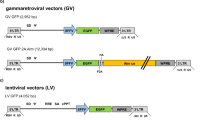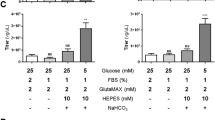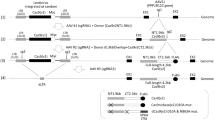Abstract
Recent reports have pointed out the difficulties in generating recombinant adenoviral vectors expressing FasL using eukaryotic cells. In the present study we cloned the murine FasL (mFasL) gene into the pCA14 or pShuttle vectors and recombined them with the adeno-5 virus backbone pBHG10 or pAdEasy-1 in eukaryotic (911 cells) or prokaryotic (E. coli) cells, respectively. Recombination of pCA14-mFasL with pBHG10 in Fas-carrying 911 cells leads to rapid expression of mFasL and cell death by apoptosis before virus replication is initiated. The same effect is observed when 911 cells are transfected with the pCA14-mFasL shuttle vector only. If recombination (pShuttle-mFasL with pAdEasy-1) is performed first in bacteria and 911 cells are transfected thereafter with recombined AdEasy-mFasL, virus production starts immediately and the cells survive longer. The resulting AdEasy-mFasL viruses are able to infect other eukaryotic cells and induce expression of functional mFasL. This study describes a method for efficient generation of recombinant FasL adeno-5 viruses in eukaryotic cells. The method may be generally suitable for producing viruses carrying deleterious genes.
This is a preview of subscription content, access via your institution
Access options
Subscribe to this journal
Receive 12 print issues and online access
$259.00 per year
only $21.58 per issue
Buy this article
- Purchase on Springer Link
- Instant access to full article PDF
Prices may be subject to local taxes which are calculated during checkout





Similar content being viewed by others
References
Nagata S . Apoptosis by death factor Cell 1997 88: 355–365
Tanaka et al. Fas ligand in human serum Nature Med 1996 2: 317–322
Arase H, Arase N, Saito T . Fas-mediated cytotoxicity by freshly isolated natural killer cells J Exp Med 1995 181: 1235–1238
Rouvier E, Luciani MF, Golstein P . Fas involvement in Ca2+-independent T cell-mediated cytotoxicity J Exp Med 1993 177: 195–200
French LE et al. Fas and Fas ligand in embryos and adult mice: ligand expression in several immune-privileged tissues and coexpression in adult tissues characterized by apoptotic cell turnover J Cell Biol 1996 133: 335–343
Leithauser F et al. Constitutive and induced expression of APO-1, a new member of the nerve growth factor/tumor necrosis factor receptor superfamily, in normal and neoplastic cells Lab Invest 1993 69: 415–429
Watanabe-Fukunaga R et al. The cDNA structure, expression, and chromosomal assignment of the mouse Fas antigen J Immunol 1992 148: 1274–1279
Griffith T, Ferguson T . The role of FasL-induced apoptosis in immune privilege Immunol Today 1997 18: 240–244
van Parijs L, Abbas A . Role of Fas-mediated cell death in the regulation of immune responses Curr Opin Immunol 1996 8: 355–361
Bellgrau D et al. A role for CD95 ligand in preventing graft rejection Nature 1995 377: 630–577
Lau HT, Stoeckert CJ . FasL – too much of a good thing? Nature Med 1997 3: 727–728
Zhang H et al. Amelioration of collagen-induced arthritis by CD95 (Apo-1/Fas)-ligand gene transfer J Clin Invest 1997 100: 1951–1957
Okamoto K et al. Induction of apoptosis in the rheumatoid synovium by Fas ligand gene transfer Gene Therapy 1998 5: 331–338
Arai H, Gordon D, Nabel EG, Nabel GJ . Gene transfer of Fas ligand induces tumor regression in vivo Proc Natl Acad Sci USA 1997 94: 13862–13867
Graham FL, Prevec L . Manipulation of adenovirus vectors. In: Murray EJ (ed) Methods in Molecular Biology. Gene Transfer and Expression Protocols. Humana Press: Clifton, NJ 1991 pp 109–128
Zhang et al. Induction of specific T-cell tolerance by adenovirus-transfected, Fas ligand-producing antigen-presenting cells Nat Biotech 1998 16: 1045–1049
Larregina AT et al. FasL induces Fas/Apo1-mediated apoptosis in human embryonic kidney 293 cells routinely used to generate E1-deleted adenoviral vectors Gene Therapy 1998 5: 563–568
Graham FL . Covalently closed circles of human adenovirus DNA are infectious EMBO J 1984 3: 2917–2922
McGrory WJ, Bautista DS, Graham FL . A simple technique for the rescue of early region I mutations into infectious human adenovirus type 5 Virology 1988 163: 614–617
Boshart M et al. A very strong enhancer is located upstream of an immediate early gene of human cytomegalovirus Cell 1985 41: 521–530
Fallaux FJ et al. New helper cells and matched early region 1-deleted adenovirus vectors prevent generation of replication-competent adenoviruses Hum Gene Ther 1998 9: 1909–1917
Fallaux FJ et al. Characterization of 911: a new helper cell line for the titration and propagation of early region 1-deleted adenoviral vectors Hum Gene Ther 1996 7: 215–222
He TC et al. A simplified system for generating recombinant adenoviruses Proc Natl Acad Sci USA 1998 95: 2509–2514
Hitt M, Bett AJ, Prevec L, Graham FL . Construction and propagation of human adenovirus vectors. In: Celis JE (ed) . Cell Biology: A Laboratory Handbook Academic Press: London 1994 479–490
Acknowledgements
This work was supported by a grant of the Bundesministerium für Bildung, Wissenschaft, Forschung und Technologie in Bonn. The 911 cell line was kindly provided by IntroGene BV, PO Box 2048, Wassenaarseweg 72, 2333 AL Leiden, The Netherlands. The AdEasy System was a kind gift of Dr Bert Vogelstein, Howard Hughes Medical Institute, Johns Hopkins Oncology Center, Baltimore, USA. We thank Dr Peter Daniel from Max-Delbrück- Centrum für Molekulare Medizin, Berlin, Germany for the mFasL cDNA.
Author information
Authors and Affiliations
Rights and permissions
About this article
Cite this article
Watzlik, A., Dufter, C., Jung, M. et al. Fas ligand gene-carrying adeno-5 AdEasy viruses can be efficiently propagated in apoptosis-sensitive human embryonic retinoblast 911 cells. Gene Ther 7, 70–74 (2000). https://doi.org/10.1038/sj.gt.3301050
Received:
Accepted:
Published:
Issue Date:
DOI: https://doi.org/10.1038/sj.gt.3301050



